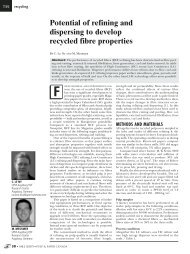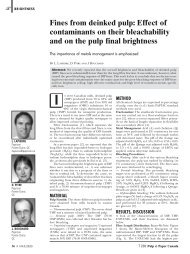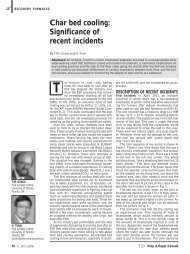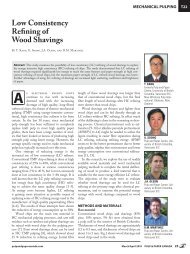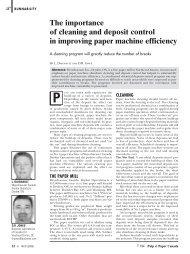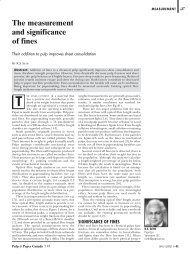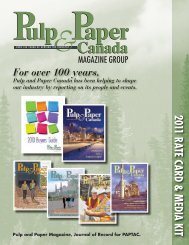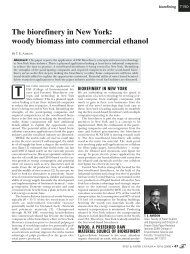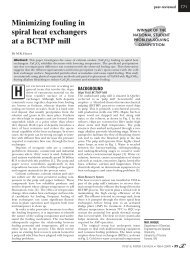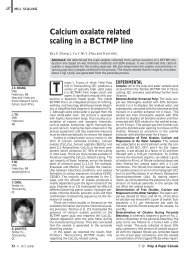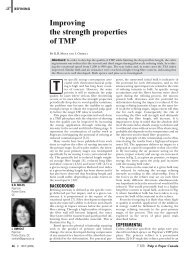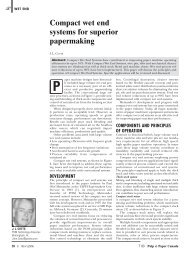Temperature and pH: Important variables for deresination in kraft ...
Temperature and pH: Important variables for deresination in kraft ...
Temperature and pH: Important variables for deresination in kraft ...
You also want an ePaper? Increase the reach of your titles
YUMPU automatically turns print PDFs into web optimized ePapers that Google loves.
BROWNSTOCK WASHING<strong>Temperature</strong> <strong>and</strong> <strong>pH</strong>:<strong>Important</strong> <strong>variables</strong> <strong>for</strong> <strong>deres<strong>in</strong>ation</strong><strong>in</strong> <strong>kraft</strong> brownstock wash<strong>in</strong>gBy L.H. Allen <strong>and</strong> C.L. Lapo<strong>in</strong>teAbstract: A Canadian softwood bleached <strong>kraft</strong> mill needed to reduce the dichloromethane extractivescontent of its pulp by half. This was achieved by rais<strong>in</strong>g the exit <strong>pH</strong> from the brownstockdecker <strong>and</strong> by <strong>in</strong>creas<strong>in</strong>g the temperature of brownstock wash<strong>in</strong>g. The results suggest that, on thebrownstock decker, a pulp exit <strong>pH</strong> less than 3 can harm <strong>deres<strong>in</strong>ation</strong> by precipitat<strong>in</strong>g the dissolved<strong>and</strong> dispersed extractives onto the fibers. In addition, the results confirm the importance of us<strong>in</strong>gthe highest temperature possible <strong>in</strong> unbleached wash<strong>in</strong>g to maximize <strong>deres<strong>in</strong>ation</strong>.SEVERAL YEARS AGO, staff <strong>in</strong> a Canadianbleached softwood <strong>kraft</strong> mill becameconcerned when one of their majorcustomers compla<strong>in</strong>ed about pitch depositionproblems. The problems appearedto be peculiar to their pulp s<strong>in</strong>ce they wereless evident when the customer used other pulps.Laboratory exam<strong>in</strong>ation of the pulp <strong>in</strong> questionrevealed a higher than normal concentration ofextractives. A quick subsequent survey <strong>in</strong>dicatedthat the extractives level of the pulp was approximatelytwice that from nearby competitors.The objective of this paper is to describe thesteps taken to successfully reduce the extractivesto an <strong>in</strong>dustry-average level.Our best underst<strong>and</strong><strong>in</strong>g of what happens to theextractives or wood res<strong>in</strong> <strong>in</strong> <strong>kraft</strong> pulp<strong>in</strong>g <strong>and</strong> wash<strong>in</strong>gis found <strong>in</strong> the recent reviews of Ström [1] <strong>and</strong>Back [2]. There exists experimental evidence that,whereas the lign<strong>in</strong> is readily removed <strong>in</strong> the earlystages of wash<strong>in</strong>g, the wood res<strong>in</strong> is removed moretoward the end of wash<strong>in</strong>g [3,4]. The rationale <strong>for</strong>this is as follows. In the <strong>kraft</strong> digester, the conditionsof high temperature (150-180°C) <strong>and</strong> alkaliconcentration cause saponification of glycerides<strong>and</strong> esters of the wood res<strong>in</strong> to yield fatty acids. Thelatter tend to <strong>for</strong>m liquid crystals, which are probablylamellar <strong>in</strong> shape <strong>and</strong> <strong>for</strong>m separate droplets[1]. On cool<strong>in</strong>g the cook below 100°C, because ofthe high ionic strength, the droplets have a tendencyto coagulate or “salt out” onto the fibers.Hence, they are relatively unavailable <strong>for</strong> removalby wash<strong>in</strong>g. It is only <strong>in</strong> the later stages of wash<strong>in</strong>g,when ionic strength has decreased sufficiently, thatthis wood res<strong>in</strong> is redispersed. In the redispersionprocess, the lamellar liquid crystall<strong>in</strong>e phase will<strong>for</strong>m micelles [5-9]. The micelles can further aid <strong>in</strong><strong>deres<strong>in</strong>ation</strong> because some of the unsaponifiableportion of the wood res<strong>in</strong> tends to dissolve <strong>in</strong> the<strong>in</strong>teriors of the micelles through a process calledsolubilization. Once redispersed, the micelles canthen be washed out. Hence, thorough wash<strong>in</strong>g isespecially important <strong>for</strong> <strong>deres<strong>in</strong>ation</strong>.There is a pronounced effect of temperatureon wash<strong>in</strong>g [10]. In the older literature there is atemperature, the Krafft temperature, <strong>for</strong> a soap,above which its solubility rises sharply [11]. Nowadays,this rapid <strong>in</strong>crease <strong>in</strong> solubility is recognizedas be<strong>in</strong>g due to the <strong>for</strong>mation of micelles.The solubility of a molecular soap is low, whereasthat of the soap as micelles is high, once the Kraffttemperature has been exceeded. There are not alot of data available <strong>for</strong> the Krafft temperatures offatty acids of wood res<strong>in</strong>, but the range of knownvalues is 32-77°C, with the saturated acids tend<strong>in</strong>gto have values toward the high end [1]. Hence the<strong>for</strong>mation of micelles upon redispersion of liquidcrystals is highly temperature dependent <strong>and</strong>brownstock wash<strong>in</strong>g of extractives from pulp isgreatly facilitated by higher temperature.The effect of temperature on wash<strong>in</strong>g appearsto be especially important <strong>in</strong> the pulp<strong>in</strong>g of p<strong>in</strong>e<strong>and</strong> a little less so <strong>in</strong> spruce, presumably becauseof the larger size of the pits <strong>and</strong> larger relative pitarea <strong>in</strong> p<strong>in</strong>e parenchyma cells, which allow easieroutward diffusion of res<strong>in</strong> components [2].The effect of <strong>pH</strong> at the last stage of wash<strong>in</strong>g,usually the brownstock decker <strong>in</strong> an older mill, hasreceived attention from several quarters. Acidificationof the brownstock screenroom is a well establishedtechnology <strong>for</strong> elim<strong>in</strong>at<strong>in</strong>g pitch deposit <strong>for</strong>mation[12-14]. Acid is added to the unbleachedwhite water to br<strong>in</strong>g the <strong>pH</strong> to a value of 6.3, ideally.Although the acidification is usually accomplishedwith SO 2 <strong>in</strong>jection or addition of sulfuricacid (most commonly), carbon dioxide is also anattractive option <strong>in</strong> some mills. Carbon dioxideaddition has been observed <strong>in</strong> mills to not onlyreduce pitch deposition <strong>in</strong> the unbleached screenroom, but also to <strong>in</strong>crease dra<strong>in</strong>age rates on thewasher <strong>and</strong> hence improve wash<strong>in</strong>g efficiency[15]. Recent work by Luthe et al. [16] has demonstratedthat the <strong>in</strong>crease <strong>in</strong> dra<strong>in</strong>age at lower <strong>pH</strong> ismore due to deaeration of the stock than to an<strong>in</strong>crease <strong>in</strong> wash<strong>in</strong>g attributable to a more porousmat of less swollen fibers at lower <strong>pH</strong>.In measurements along the fiberl<strong>in</strong>e, the extractiveshave <strong>in</strong>variably been observed to decreasemonotonically <strong>in</strong> the unbleached part ofthe mill [17,4]. Such studies, if extended to thebleach plant, usually reveal a substantial (50-100%) <strong>in</strong>crease <strong>in</strong> extractives dur<strong>in</strong>g the first stageof bleach<strong>in</strong>g. This has been attributed <strong>in</strong> part tothe coagulation of the dispersed res<strong>in</strong> particlesonto the pulp fibers [18]. The dispersed res<strong>in</strong>droplets are colloidally destabilized below <strong>pH</strong> 3,due to the protonation of carboxylate groups.Without sufficient electrostatic charge <strong>for</strong> stability,L.H. ALLENPapricanPo<strong>in</strong>te-Claire,QCC.L. LAPOINTEPapricanPo<strong>in</strong>te-Claire,QCPulp & Paper Canada T 294 104:12 (2003) ❘❘❘ 59
BROWNSTOCK WASHINGFIG. 1. Orig<strong>in</strong>al extractives profile <strong>and</strong> results of trials <strong>in</strong>which fresh water was used on the brownstock deckershowers. In the orig<strong>in</strong>al profile (black bars) the extractivescontent of the pulp was higher after the decker than afterthe last brownstock washer, which is unusual <strong>in</strong> <strong>kraft</strong>mills. Subsequent trials of us<strong>in</strong>g less acidic fresh water <strong>in</strong>the decker showers raised the <strong>pH</strong> <strong>and</strong> lowered the extractivescontent of the pulp after the decker.the res<strong>in</strong> droplets collide with fibers <strong>and</strong> adhere to them [18,19].There are, of course, additional reasons that the extractives onfibers <strong>in</strong>crease <strong>in</strong> the first stage of bleach<strong>in</strong>g <strong>and</strong> these <strong>in</strong>cludethe addition of chlor<strong>in</strong>e to double bonds of wood res<strong>in</strong> components(thus <strong>in</strong>creas<strong>in</strong>g molecular weight) <strong>and</strong> the precipitationof dissolved soaps onto the fibers with the low <strong>pH</strong>. The precipitationof dispersed extractives <strong>and</strong> soaps onto the fibers at low <strong>pH</strong>through an unusual circumstance became an important aspect of<strong>in</strong>creas<strong>in</strong>g the efficiency of wash<strong>in</strong>g on the brownstock decker ofthe mill <strong>in</strong> this study.EXPERIMENTALMillThe mill is a bleached softwood <strong>kraft</strong> market pulp mill located <strong>in</strong>central Canada <strong>and</strong> employ<strong>in</strong>g a mixture of black spruce <strong>and</strong> jackp<strong>in</strong>e. As is often the case with older mills, most of the washers <strong>in</strong> themill are operat<strong>in</strong>g at 20% above design capacity. Saltcake losses atthe brownstock decker run at 9-12 kg/t, which <strong>in</strong>dicates brownstockwash<strong>in</strong>g that is <strong>in</strong> the normal-to-poor range <strong>for</strong> <strong>kraft</strong> pulp mills[12]. Brownstock wash<strong>in</strong>g is accomplished with a pressure diffuserfollowed by two rotary drum washers. The f<strong>in</strong>al brownstock wash<strong>in</strong>gis done on a decker after the screen room. At the time of the work,the bleach plant employed a DcEoHD 1 E 2 D 2 sequence (10% Cl 2 <strong>in</strong>first stage; mill has subsequently converted to ECF) <strong>and</strong> filtrates arecountercurrent (vs. split jump-stage) recycled. Prior to the work described<strong>in</strong> this paper, the mill was employ<strong>in</strong>g a “cold blow” <strong>for</strong>greater pulp strength [20] <strong>and</strong> this led to lower temperatures acrossthe fiberl<strong>in</strong>e. The f<strong>in</strong>al temperature of stock from the pressure diffuserwas usually <strong>in</strong> the range 75-90°C, but it sometimes dropped toas low as 50°C. Fresh water was used at the mill (seal water, cool<strong>in</strong>gwater, <strong>and</strong> process water) at a rate of 100 m 3 /t. Throughout thework, no talc was used, but a total of 0.1 kg/t of a commercial pitchdispersant (Consperce VIIA, Constant Laboratories) was used <strong>in</strong>the bleach plant at the Dc repulper <strong>and</strong> the decker white waterchest be<strong>for</strong>e the pulp mach<strong>in</strong>e.Be<strong>for</strong>e the trial, the DCM extractives content of the driedpulp typically ranged from 0.11-0.18%, depend<strong>in</strong>g on the woodsupplied to the digester. Benchmark<strong>in</strong>g of the extractives contentof the bleached pulp with 16 other NBSK mills suggestedFIG. 2. Dispersed extractives concentration <strong>in</strong> a <strong>kraft</strong> millunbleached pulp suspension as a function of <strong>pH</strong>. Below <strong>pH</strong>3, the extractives particles are coagulated onto the fibres<strong>and</strong> f<strong>in</strong>es, <strong>and</strong> cannot be washed from the pulp.that the extractives level was runn<strong>in</strong>g at approximately twice theaverage value. This higher extractives content was felt to be alarge contribut<strong>in</strong>g factor to deposits <strong>in</strong> a customer paper millwhere the deposits were especially evident downstream of the<strong>kraft</strong> repulper, on the consistency sensor.Sampl<strong>in</strong>g at the MillSampl<strong>in</strong>g was done at eleven po<strong>in</strong>ts along the fiberl<strong>in</strong>e, as <strong>in</strong>dicated<strong>in</strong> Figure 1. For drum washers, the samples were taken atthe doctor. Each sample was composed of equal amounts of pulptaken from the center <strong>and</strong> from each side of the drum to take<strong>in</strong>to account the variation <strong>in</strong> wash<strong>in</strong>g across the width of thedrum. Care was taken to obta<strong>in</strong> the complete thickness of thefiber mat with each sample, because the pulp on top would bebetter washed than that on the bottom. At the blowl<strong>in</strong>e, the pulpwas sampled as blown from the digester <strong>and</strong> be<strong>for</strong>e dilution. Thepulp was then vacuum filtered on a Büchner funnel to elim<strong>in</strong>ateas much black liquor as possible, be<strong>for</strong>e shipment to Paprican.An ef<strong>for</strong>t was made to sample along the fiberl<strong>in</strong>e tak<strong>in</strong>g <strong>in</strong>toconsideration the residence time of the pulp at each site. Threesets of samples were obta<strong>in</strong>ed with at least half an hour betweeneach set. At our laboratory, the three samples from each sitewere comb<strong>in</strong>ed <strong>and</strong> the <strong>pH</strong> of the filtrate from each resultantpulp was measured. The pulps were centrifuged at our pilotplant to a consistency of approximately 30%. The thickenedpulps were then fluffed, frozen <strong>and</strong> freeze-dried.ExtractionsThe freeze-dried pulps were extracted with dichloromethane(DCM) <strong>in</strong> a Soxhlet extractor [21]. The volume of solvent wasreduced on a rotary evaporator <strong>and</strong> the rema<strong>in</strong><strong>in</strong>g solvent <strong>and</strong>extracts were transferred to a pre-weighed vial. The rest of thesolvent was then evaporated under nitrogen <strong>and</strong> the dry extractswere freeze-dried <strong>for</strong> one night. Us<strong>in</strong>g these procedures, thest<strong>and</strong>ard deviation <strong>for</strong> bleached softwood <strong>kraft</strong> pulp at 0.04% extractivesis ±5%.RESULTS AND DISCUSSION1. Extractives Profile Across MillWe began by determ<strong>in</strong><strong>in</strong>g the DCM extractives content of pulpsat various po<strong>in</strong>ts along the fiberl<strong>in</strong>e. The results are shown withblack bars <strong>in</strong> Figure 1. It is evident that extractives start high atthe digester blowl<strong>in</strong>e (0.93%) <strong>and</strong> are greatly decreased by theend of the brownstock washers to 0.19%.60 ❘❘❘ 104:12 (2003) T 295 Pulp & Paper Canada
TABLE I. Extractives profiles <strong>and</strong> <strong>pH</strong> values along fibrel<strong>in</strong>e.BROWNSTOCK WASHINGTrials with fresh water used <strong>in</strong> decker showersOrig<strong>in</strong>al profileDiffusion washer Diffusion washerF<strong>in</strong>al profile<strong>in</strong> operationdownExtractives* <strong>pH</strong> Extractives* <strong>pH</strong> Extractives* <strong>pH</strong> Extractives* <strong>pH</strong>(%) (%) (%) (%)Digester blowl<strong>in</strong>e 0.93 12.3 1.22 12.3 0.46 11.7 1.39 12.62nd brownstock washer 0.19 10.3 0.22 10.4 0.23 10.5 0.20 10.5Brownstock decker 0.28 2.4 0.18 9.2 0.20 9.8 0.17 9.9Dc washer 0.24 9.6 0.14 12.3Eo washer 0.20 9.4 0.13 11.9H washer 0.22 8.0 0.13 9.8D 1 washer 0.18 8.6 0.10 10.0E 2 washer 0.16 9.3 0.08 10.5D 2 washer 0.21 4.7 0.09 4.8Pulp mach<strong>in</strong>e headbox 0.21 4.4 ND** ND**Dried pulp 0.17 NA*** 0.10 NA*** 0.15 NA*** 0.08 NA****DCM extractives content of pulp ***Not determ<strong>in</strong>ed ***Not applicableIt was startl<strong>in</strong>g to discover that the extractives content of thepulp actually <strong>in</strong>creased at the brownstock decker. They rise from0.19% at the #2 brownstock washer to 0.28% at the decker. Webelieve this result to be significant <strong>and</strong> beyond experimentalerror <strong>and</strong> the r<strong>and</strong>om variation that occurs with time <strong>in</strong> theextractives measurement at a s<strong>in</strong>gle po<strong>in</strong>t <strong>in</strong> a mill. This result isunusual, <strong>in</strong> that mill extractives profiles reported earlier havealways shown a decrease at the decker.Follow<strong>in</strong>g the brownstock decker, the pulp proceeds to thebleach plant, where extractives values generally rema<strong>in</strong>ed constant,except <strong>for</strong> small variations. The latter <strong>in</strong>clude slightdecreases <strong>in</strong> the extractives content after both E stages <strong>and</strong> small<strong>in</strong>creases <strong>in</strong> extractives after the H <strong>and</strong> D 2 stages. The high <strong>pH</strong>values <strong>in</strong> the E stages make them opportunities <strong>for</strong> some <strong>deres<strong>in</strong>ation</strong>[18]. The m<strong>in</strong>or <strong>in</strong>creases <strong>in</strong> extractives <strong>in</strong> the H <strong>and</strong>D 2 stages may be due to the addition of chlor<strong>in</strong>e to doublebonds <strong>in</strong> the res<strong>in</strong> molecules, which would result <strong>in</strong> a highermolecular weight <strong>and</strong> hence a higher res<strong>in</strong> density.It is evident from Figure 1 that most of the <strong>deres<strong>in</strong>ation</strong> isdone <strong>in</strong> the unbleached part of the mill <strong>and</strong> not much reductionis achieved <strong>in</strong> the bleach plant. Usually, a little more <strong>deres<strong>in</strong>ation</strong>can be achieved [18]. Un<strong>for</strong>tunately, the bleach plant<strong>in</strong> this mill was constructed with shorter-than-conventional droplegson all the washers, so that the <strong>in</strong>ternal vacuums <strong>in</strong> the washersare lower than <strong>in</strong>dustry norm.FIG. 3. Orig<strong>in</strong>al <strong>and</strong> f<strong>in</strong>al extractives profiles. Black barsshow orig<strong>in</strong>al profile. Gray bars give extractives contentsof pulps after both the <strong>pH</strong> changes on the decker <strong>and</strong> the<strong>in</strong>creases <strong>in</strong> brownstock wash<strong>in</strong>g temperatures.2. Brownstock Decker Trials (Fresh Water; Higher <strong>pH</strong>)The brownstock decker of this mill was operated with only Dc filtratego<strong>in</strong>g to the shower bars. As a result, the <strong>pH</strong> of the exit pulpwas 2.4 (Table I). Previous work at Paprican [18], shown <strong>in</strong> Figure2, has <strong>in</strong>dicated that at <strong>pH</strong> values less than 3, the dispersedwood res<strong>in</strong> is coagulated onto the fibers <strong>and</strong> it drops to about aquarter of its orig<strong>in</strong>al concentration <strong>in</strong> suspension at <strong>pH</strong> 2.4.We reasoned that this would account <strong>for</strong> the <strong>in</strong>creased extractiveson the pulp at the brownstock decker <strong>and</strong> conducted several trials<strong>in</strong> which fresh water at 60°C was used <strong>in</strong>stead. Two such trials wereconducted <strong>and</strong>, dur<strong>in</strong>g the second, the diffuser washer was down.The results are given <strong>in</strong> Table I <strong>and</strong> Figure 1. The <strong>pH</strong> valuesof the stock com<strong>in</strong>g from the decker rose to 9.2 <strong>and</strong> 9.8 (TableI) <strong>and</strong>, as shown by the open <strong>and</strong> hatched bars <strong>in</strong> Figure 1, theextractives were lower (0.18 <strong>and</strong> 0.20 vs. 0.28%). Moreover, withthis drop <strong>in</strong> extractives, there is now a monotonic decrease alongthe unbleached fiberl<strong>in</strong>e, as observed <strong>in</strong> other mills <strong>in</strong> the past.To put the preced<strong>in</strong>g a little more <strong>in</strong> perspective, it is probablyworth not<strong>in</strong>g that Dc or D 0 filtrate can often be used <strong>in</strong> <strong>and</strong> aroundthe brownstock decker with benefits. In a conventional <strong>kraft</strong> milllack<strong>in</strong>g oxygen delignification, it is common practice to use D 0 filtrateto lower <strong>pH</strong> at the exit of the unbleached high-density storagetank <strong>in</strong> preparation <strong>for</strong> the D 0 stage to save on ClO 2 costs. Furthermore,some mills use D 0 filtrate on the brownstock decker tolower <strong>pH</strong> <strong>in</strong> preparation <strong>for</strong> enzyme treatment <strong>in</strong> high-density storage.These practices are not likely to cause precipitation of the dispersedextractives onto the fibers, as seen <strong>in</strong> Figure 1 (orig<strong>in</strong>al profile),unless the <strong>pH</strong> of the pulp pad falls to values less than 3.3. Higher <strong>Temperature</strong>sThe next step undertaken was to <strong>in</strong>crease the temperature ofbrownstock wash<strong>in</strong>g.To accomplish this, two approaches were taken.• Mill personnel replaced some brownstock washer shower waterwith clean evaporator condensate at 90°C.• The digester stock temperature at the blow valve was<strong>in</strong>creased by about 10°C.Several days after the process had reached steady state, we tooksamples <strong>for</strong> a second extractives profile across the mill. The resultsare shown <strong>in</strong> Figure 3 (gray bars). For comparison, the orig<strong>in</strong>al pro-Pulp & Paper Canada T 296 104:12 (2003) ❘❘❘ 61
BROWNSTOCK WASHINGfile results are shown with black bars. Overall,there was a significant improvement <strong>in</strong>the DCM extractives across the fiberl<strong>in</strong>e.The most significant change was a smalldecrease <strong>in</strong> DCM extractives at the decker,<strong>in</strong>stead of the <strong>pH</strong>-<strong>in</strong>duced jump evident <strong>in</strong>the orig<strong>in</strong>al profile. Most importantly <strong>for</strong>customers, the extractives content of thedried, fully bleached pulp, was now reducedby over 50%. This, despite a significantlyhigher DCM extractives content <strong>in</strong> the blowl<strong>in</strong>e(1.39%, probably attributable to thewood) after the changes than <strong>in</strong> the orig<strong>in</strong>alextractives profile (0.93%).There was no noticeable change observed<strong>in</strong> pulp tear or tensile at the timeof the temperature <strong>in</strong>creases <strong>and</strong> therehas been no detectable change s<strong>in</strong>cethen. This observation is, of course, tentatives<strong>in</strong>ce there is always considerable variation<strong>in</strong> both the wood <strong>and</strong> the process.CONCLUSIONSElim<strong>in</strong>ation of excessive amounts of Dcstagefiltrate to the brownstock decker (toraise the unusually low pulp exit <strong>pH</strong> above3) <strong>and</strong> an <strong>in</strong>crease <strong>in</strong> brownstock wash<strong>in</strong>gtemperatures have comb<strong>in</strong>ed to produce asignificant decrease (~50%) <strong>in</strong> the extractivescontent of the fully bleached pulp.At the customer paper mill, thesechanges have alleviated the deposition prob-Résumé: Une us<strong>in</strong>e canadienne de pâte <strong>kraft</strong> blanchie de rés<strong>in</strong>eux devait réduire de moitié lateneur en dichlorométhane (produit d’extraction du bois) de sa pâte. Pour ce faire, on a élevé le<strong>pH</strong> de sortie de l’épaississeur de pâte brune et augmenté la température du lavage de la pâtebrune. Les résultats suggèrent que, dans l’épaississeur de pâte brune, un <strong>pH</strong> de sortie <strong>in</strong>férieur à3 peut nuire à la dispersion de la rés<strong>in</strong>e en précipitant les matières extractives dissoutes et disperséessur les fibres. En outre, les résultats confirment l’importance d’employer la températurela plus élevée possible lors du lavage de la pâte écrue af<strong>in</strong> de maximiser la dispersion de la rés<strong>in</strong>e.Reference: ALLEN, L.H., LAPOINTE, C.L. <strong>Temperature</strong> <strong>and</strong> <strong>pH</strong>: <strong>Important</strong> <strong>variables</strong> <strong>for</strong><strong>deres<strong>in</strong>ation</strong> <strong>in</strong> <strong>kraft</strong> brownstock wash<strong>in</strong>g. Pulp & Paper Canada 104(12): T294-297 (December,2003). Paper presented at the 89th Annual Meet<strong>in</strong>g <strong>in</strong> Montreal, QC, on January 28-30, 2003. Notto be reproduced without permission of PAPTAC. Manuscript received on April 11, 2003. Revisedmanuscript approved <strong>for</strong> publication by the Review Panel on June 2, 2003.Keywords: KRAFT MILLS, KRAFT PULPS, BLEACHED PULPS, SOFTWOOD PULPS,EXTRACTIVES, METHANE, PH, TEMPERATURE, WASHING, UNBLEACHED PULPS.lem experienced earlier on the consistencysensor downstream of the <strong>kraft</strong> repulper.The results suggest that, on the brownstockdecker, a pulp exit <strong>pH</strong> less than 3 canharm <strong>deres<strong>in</strong>ation</strong> by precipitat<strong>in</strong>g theextractives onto the fibers. In addition, theyconfirm the importance [2,4] of us<strong>in</strong>g thehighest temperature possible <strong>in</strong> unbleachedwash<strong>in</strong>g to achieve maximum <strong>deres<strong>in</strong>ation</strong>.LITERATURE1. STRÖM, G., “Physico-Chemical Properties <strong>and</strong> SurfactantBehavior”, <strong>in</strong> Pitch Control, Wood Res<strong>in</strong> <strong>and</strong>Deres<strong>in</strong>ation, E. Back <strong>and</strong> L.H. Allen, eds., ch. 5, TAP-PI Press, Atlanta, pp. 139-149 (2000).2. BACK, E.L., “Deres<strong>in</strong>ation <strong>in</strong> Pulp<strong>in</strong>g <strong>and</strong> Wash<strong>in</strong>g”,<strong>in</strong> Pitch Control, Wood Res<strong>in</strong> <strong>and</strong> Deres<strong>in</strong>ation, E.Back <strong>and</strong> L.H. Allen, eds., ch. 8, TAPPI Press, Atlanta,pp. 205-230 (2000).3. BERGSTRÖM, H. <strong>and</strong> CEDERQVIST, K.N., “Occurrenceof Res<strong>in</strong> Acids <strong>in</strong> Black Liquor <strong>and</strong> Wash Water”,Svensk Papperstid. 40(5):112 [<strong>in</strong> Swedish] (1937).4. TUFVESSON, M., BJÖRKLUND JANSSON, M., <strong>and</strong>BACK, E.L., SCAN Report 502, “Softwood Res<strong>in</strong> <strong>in</strong> KraftPulp<strong>in</strong>g <strong>and</strong> Subsequent Wash<strong>in</strong>g”, [<strong>in</strong> Swedish], (1987).5. STENIUS, P., PALONEN, H., STRÖM, G., <strong>and</strong>ÖDBERG, L., “Micelle Formation <strong>and</strong> Phase Equilibriaof Surface Active Components of Wood”, <strong>in</strong> Surfactants<strong>in</strong> Solution, K.L. Mittal <strong>and</strong> B. L<strong>in</strong>dman, eds.,Plenum Publish<strong>in</strong>g, New York, Vol. I, p. 153 (1984).6. PALONEN, H., STENIUS, P., <strong>and</strong> STRÖM, G., “SurfactantBehavior of Wood Res<strong>in</strong> Components: TheSolubility of Ros<strong>in</strong> <strong>and</strong> Fatty Acid Soaps <strong>in</strong> Water <strong>and</strong><strong>in</strong> Salt Solutions”, Svensk Papperstid. 85:R93 (1982).7. STRÖM, G., STENIUS, P., LINDSTRÖM, M., <strong>and</strong>ÖDBERG, L., “Surface Chemical Aspects of theBehavior of Soaps <strong>in</strong> Pulp Wash<strong>in</strong>g”, Nordic Pulp Pap.Res. J., 5(1):44 (1990).8. LINDSTRÖM, M., ÖDBERG, L., <strong>and</strong> STENIUS, P.,“Res<strong>in</strong> <strong>and</strong> Fatty Acids <strong>in</strong> Kraft Pulp Wash<strong>in</strong>g. PhysicalState, Colloid Stability <strong>and</strong> Washability”, Nordic PulpPap. Res. J., 3(3):100 (1988).9. ÖDBERG, L., FORSBERG, S., MCBRIDE, G., PERS-SON, M., STENIUS, P., <strong>and</strong> STRÖM, G., “SurfactantBehavior of Wood Res<strong>in</strong> Components. Part 2. Solubilization<strong>in</strong> Micelles of Ros<strong>in</strong> <strong>and</strong> Fatty Acids”, SvenskPapperstid, 88(12):R118 (1985).10. BJÖRKLUND JANSSON, M., BACK, E.L., <strong>and</strong>TUFVESSON, M.I., “A Review of Kraft Pulp Deres<strong>in</strong>ation<strong>and</strong> Pitch Problems”, 1985 Trans. VIIIth FundamentalResearch Symposium Notes, Mech. Eng. Publ.,London, p. 729.11. KRAFFT, F. <strong>and</strong> WIGLOW, H., “On the Behaviorof Fatty Acid Alkalies <strong>and</strong> their Soaps <strong>in</strong> the Presenceof Water. IV. Soaps as Crystalloids”, Chem. Ber. 28:2566[<strong>in</strong> German] (1895).12. ALLEN, L.H., “Pitch Control <strong>in</strong> Pulp Mills”, <strong>in</strong> PitchControl, Wood Res<strong>in</strong> <strong>and</strong> Deres<strong>in</strong>ation, E. Back <strong>and</strong> L.H. Allen,eds., ch.11, TAPPI Press, Atlanta, pp. 269-291 (2000).13. AFFLECK, R.R., <strong>and</strong> RYAN, R.G., “Pitch Control <strong>in</strong> aKraft Pulp Mill”, Pulp Pap. Mag. Can., 70(24):107 (1969).14. ALLEN, L.H., “The Importance of <strong>pH</strong> <strong>in</strong> Controll<strong>in</strong>gMetal-Soap Deposition”, Tappi J., 71(1):61-64 (1988).15. GIRARD, R., HO, C., GUTHRIE, P., <strong>and</strong> CAMPBELL,P., “The Effects of Carbon Dioxide on the Efficiency ofVarious Brownstock Washers”, <strong>in</strong> Proc. 1999 TAPPI Pulp<strong>in</strong>gConf., TAPPI Press, Atlanta, Vol. 3, p. 1225.16. LUTHE, C., BERRY, R., <strong>and</strong> NADEAU, L., “HowDoes Carbon Dioxide Improve Brownstock Wash<strong>in</strong>g?”Prepr<strong>in</strong>ts CD, 2003 TAPPI Fall Tech Conf., Session 12,paper 3.17. JONASSON, R.G., FUHR, B., SITHOLÉ, B.B., <strong>and</strong>ALLEN, L.H., “Studies on the Occurrence of Glycosides<strong>in</strong> Aspen Wood <strong>and</strong> Kraft Pulp”, <strong>in</strong> prepr<strong>in</strong>ts, 9thInternational Symposium on Wood <strong>and</strong> Pulp<strong>in</strong>gChemistry, CPPA, Montreal, pp. 43/1-6, June (1997).18. ALLEN, L.H. <strong>and</strong> LAPOINTE, C.L., “Physical Distributionof Res<strong>in</strong> <strong>in</strong> Bleached Kraft Pulp Mills”, Pulp Pap. Can.,88(12):T483-490 (1987); Pulp Pap. Can. 89(3):9 (1988).19. ALLEN, L.H., “Pitch <strong>in</strong> Wood Pulps”, Pulp Pap.Can., 76(5): T139-146 (1975).20. CYR, M.E., EMBLEY, D.F., <strong>and</strong> MACLEOD, J.M.,“Stronger Kraft Softwood Pulp -Achieved!”, Tappi J.,72(10):157-163 (1989).21. PAPTAC St<strong>and</strong>ard Test<strong>in</strong>g Methods G.13 <strong>and</strong> G.20.62 ❘❘❘ 104:12 (2003) T 297 Pulp & Paper Canada



